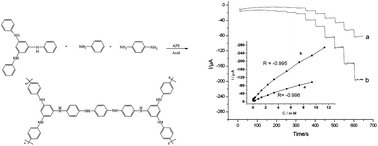Improved electrocatalytic behavior of ascorbic acid by crosslinked polyaniline with enhanced conductivity
Abstract
A newly designed crosslinked

* Corresponding authors
a
Key Laboratory on Luminescence and Real-Time Analysis, Ministry of Education, School of Chemistry and Chemical Engineering, Southwest University, Chongqing, PR China
E-mail:
xulan@swu.edu.cn
Fax: +86-23-68254000
Tel: +86-23-68253544
A newly designed crosslinked

 Please wait while we load your content...
Something went wrong. Try again?
Please wait while we load your content...
Something went wrong. Try again?
S. Chen, L. Xu, Y. Yang, B. Li and J. Hou, Anal. Methods, 2011, 3, 2374 DOI: 10.1039/C1AY05310H
To request permission to reproduce material from this article, please go to the Copyright Clearance Center request page.
If you are an author contributing to an RSC publication, you do not need to request permission provided correct acknowledgement is given.
If you are the author of this article, you do not need to request permission to reproduce figures and diagrams provided correct acknowledgement is given. If you want to reproduce the whole article in a third-party publication (excluding your thesis/dissertation for which permission is not required) please go to the Copyright Clearance Center request page.
Read more about how to correctly acknowledge RSC content.
 Fetching data from CrossRef.
Fetching data from CrossRef.
This may take some time to load.
Loading related content
